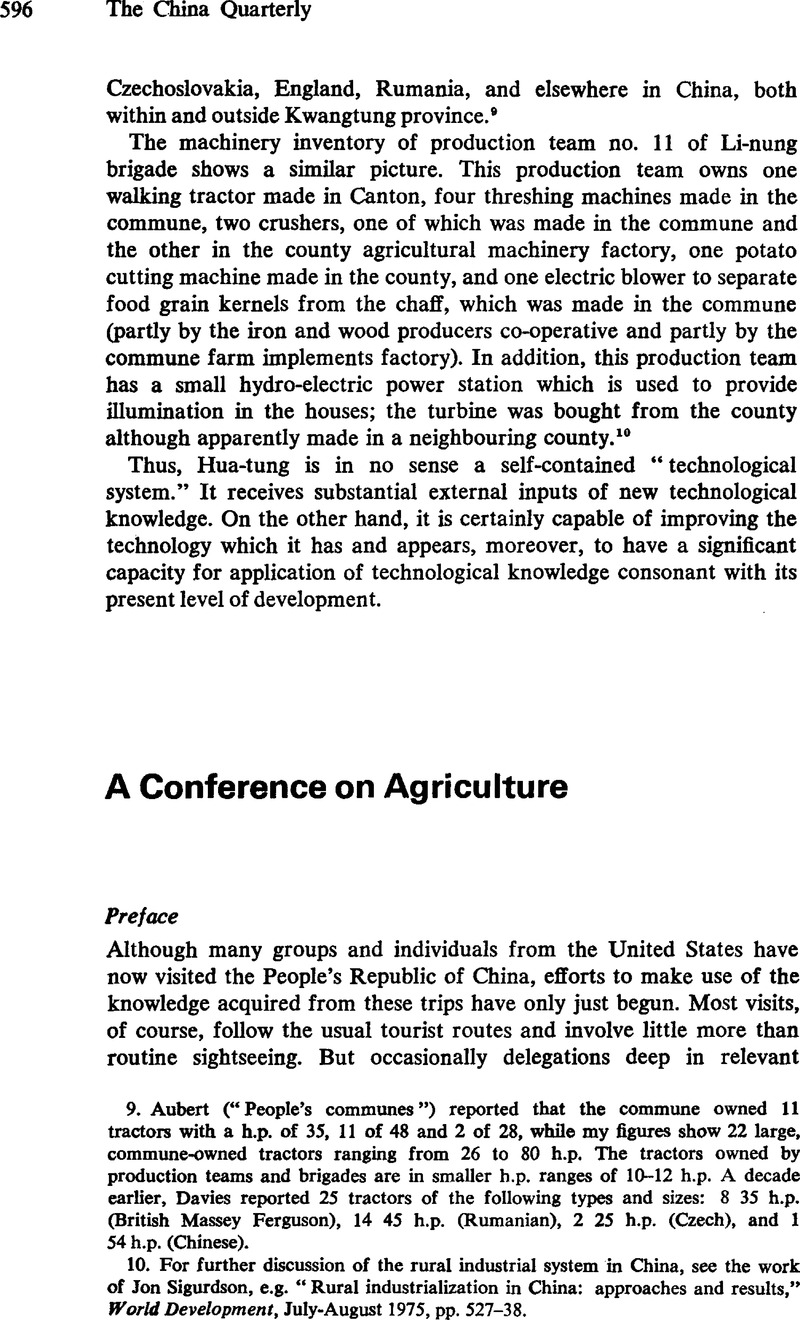Article contents
A Conference on Agriculture
Published online by Cambridge University Press: 17 February 2009
Abstract

- Type
- Reports from China
- Information
- Copyright
- Copyright © The China Quarterly 1976
References
1. Lists of some of the places visited by each delegation and of the participants in the conference are set out in the Appendix to this report (pp. 608–610). Another, brief, report of the conference may be found in Science and Public Policy, September 1975, pp. 387–89.
2. In the words of an India specialist and economist: “Mechanization in India and elsewhere has generally been associated with increased labor use. It has also been in a sense a weapon of class warfare putting some out of work, but this latter problem doesn't arise in the Chinese context.”
3. According to one plant scientist: “One of the things that is so impressive is how beautifully kept these plots are. They use chemicals to some extent, but they are basically a labor saving device. This is a whole aspect of Chinese agriculture that is very different from ours. They haven't shifted as much to biological systems as they might have and the pesticides they are using are outdated.”
4. Plant Studies in The People's Republic of China (Washington, D.C.: National Academy of Sciences, 1975).Google Scholar
5. In the words of one plant scientist: “They have apparently expanded the wheat acreage a great deal, first by planting it in the winter in the south, with rice in the summer. They have also expanded some of the wheat acreage in the north. They still have a way to go in denning the areas in which they will grow winter wheat and spring wheat.”
6. According to one plant scientist: “There was a little bit of research on citrus fruits, but not comparable to apples and pears. The station we visited still reflects the Japanese influence of the past.”
7. As described by one plant scientist: “ In south China one of the interesting and very intensive fruit production programs was that dealing with dried apricots in which they are harvested from the trees, salted and then sweetened with sugar and honey … this was a very intensive operation in which the fruits were wrapped and packed by hand. Only one machine was used, and that to make labels.”
8. According to one plant scientist: “ Turf - there is a place for a lot more work. The Chinese are at the same point as south Georgia in 1936. Courtyards are stripped of all vegetation. Putting in turf would keep mud out of homes, provide feed for chickens, etc.”
9. According to one delegation member: “If you could hybridize the Indian and Chinese agricultural research and extension systems, you would have a very good system. India now has some very sophisticated research capacities and is very poor between the research organizations and the farmer. Between them and the farmer they are weak whereas between such organizations and the farmer China is strong. But China doesn't have anything behind it. Both of them have great gaps and the Chinese system has a great gap in the more sophisticated work. It is probably easier to create the research part once the extension part is in place, however, than vice versa.”
10. “We were told that this is a transitional phase and that the best of the people working with the farmers would be reconstituted into central research teams; they will be reconstituted with people all of whom have experience at the farm level. Unless they do that they are going to stagnate.”
11. Plant scientist: “There seems to be a paradox. In some fields their research capacity seems to be rather substantial, much greater than what we saw in agriculture.”
12. Plant scientist: “I would see some very real problems in catching up under the present educational and training system. I don't think they'll ever catch up as long as they stick to the present system of identifying people and training people to move on into important research jobs. I don't think the system permits this.”
13. According to one member of the Water Resources Delegation: “In India, you may get the same amount of rain but all in three months followed by seven or eight months of deficiency and this may account for some of the India-China productivity differences.”
14. Water Resources Delegation member: “We were struck by the quality of farm water management. In contrast to the India-Pakistan subcontinent where better management would double or triple production, improving water manage-ment in China would get very little increase in production. The level of water management in China is exceptionally high. This conclusion is based on a visual impression of the fields and knowledge of the yields achieved.”
15. Water Resources Delegation member: “A lot of our technological art has come from the guy on the machine tool. Maybe they have capitalized on this a little more than we have. Certainly they have recognized this possibility more.”
16. Water Resources Delegation member: “Except for the engineering technology of large dams, locks, and hydraulic machinery, they seem to be up to the best state of the art - about the same level as American hydraulic engineering. There is a tremendous machine capability to build turbines, pumps, valves, everything they need. I don't suppose they can build as large a turbine as we can in the U.S., but we saw some large pumps.”
- 2
- Cited by




